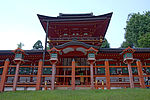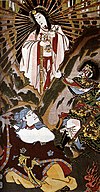Futsunushi
| Futsunushi-no-Kami | |
|---|---|
God of swords and warfare | |
Sendai Kuji Hongi | |
| Personal information | |
| Parents | Iwatsutsunoo and Iwatsutsunome |
| Children | Ame-no-Naemasu-no-Mikoto |
Futsunushi (経津主神, Futsunushi-no-Kami, also 布都怒志命 or 布都努志命, Futsunushi-no-Mikoto), also known as Iwainushi (斎主神 or 伊波比主神, Iwainushi-no-Kami), is a
Name
One theory interprets the futsu (Old Japanese: putu) in Futsunushi's name as an onomatopoeic sound of a sword swinging and cutting something,[4][5][6] while another theory proposes it to be derived from the Korean word for 'fire' or 'brilliance', pul (불).[3][5] A connection with the term furu ('to shake') has also been proposed.
Nushi (OJ: nusi), meaning 'master' or 'ruler', is derived from a contraction of the possessive particle no and ushi (OJ: usi), of the same meaning.[7]
The name Iwainushi (historical orthography: いはひぬし, Ihahinushi; OJ: Ipapinusi) meanwhile is a contraction of iwai no ushi (斎之大人), 'master of worship'.[3][8][9]
Mythology
Parentage
A variant account of
Subjugation of the land
Nihon Shoki

Both Futsunushi and Takemikazuchi are closely associated with the 'transfer of the land' (
The main narrative of the second volume of the Nihon Shoki relates that after the failure of the earlier messengers, Ame-no-Hohi and Ame-no-Wakahiko, to perform their mission, the gods of heaven headed by the primordial deity
A variant account has Futsunushi and Takemikazuchi putting to death the evil deity Amatsumikaboshi (Kagaseo) in heaven first before they descend to Izumo. The account adds that it was at this time that Iwainushi-no-Kami (possibly another name for Futsunushi), the deity enshrined in
Other texts

Two legends from Ou District (意宇郡) of Izumo Province (modern Yasugi, Shimane Prefecture) recorded in the Izumo Fudoki feature Futsunushi.
Township of Tatenuhi. It is 10.7 miles northeast of the district office. At this place Futsunushi stitched up a rip in his sturdy shield of heaven. Thus it was named Tatenuhi, meaning "shield fastening."
Township of Yamakuni. It is 10.9 miles southeast of the district office. Futsunushi came to this place during a campaign. He said, "This is the land I wish to behold forever." Because of this the place is called Yamakuni, meaning "land to behold forever."[14]
The Fudoki of Hitachi Province (modern Ibaraki Prefecture) also refers to a deity named 'Futsu-no-Ōkami' (普都大神) who is often identified with Futsunushi.
District of Shida. . . . An elder reports that at the beginning of Heaven and Earth, when the vegetal world was speaking words, a kami came from Heaven. Its name is the Great kami Futsu. In its rounds of the Central Plain of Reeds [Japan], it pacified various rebels. Once this Great kami had accomplished its work of civilization, it conceived in its heart the desire to return to its celestial abode. It therefore left its weapons and gear on earth, and, mounting a white cloud, returned to Heaven.[3]
The kuni-yuzuri myth featured in the Izumo no Kuni no Miyatsuko no Kanʼyogoto (出雲国造神賀詞 "Congratulatory Words of the Chieftain of Izumo"), a ritual declaration (norito) delivered by the province's governor or kuni no miyatsuko at the imperial court upon his appointment, has Futsunushi being dispatched with the deity Ame-no-Hinadori-no-Mikoto (天夷鳥命), the son of Ame-no-Oshihomimi, son of the sun goddess Amaterasu and the Izumo magnate clan's divine ancestor.[15][16][17]
Futsunushi is absent in the Kojiki, where the envoys sent by the heavenly kami are Takemikazuchi and the bird-boat deity Ame-no-Torifune.[18] The Kojiki's kamiumi myth identifies Takemikazuchi - here given the aliases 'Takefutsu-no-Kami' (建布都神) and 'Toyofutsu-no-Kami' (豊布都神) - as one of three gods born from the blood that fell from the blade of Izanagi's sword (the other two being Mikahayahi and Hihayahi),[19] although the kuni-yuzuri portion refers to him as the son of the deified sword itself, there given the name Itsu-no-Ohabari (伊都尾羽張).[18]
The Sobataka deity

Sobataka Shrine (側高神社) in Ōkura, Katori is reckoned as the first and most important auxiliary shrine of Katori Jingū. Its deity, whose identity is kept secret since antiquity and thus is known merely as the 'Great Deity of Sobataka' (側高大神 Sobataka-no-Ōkami),[20] is the subject of a legend involving the god of Katori Shrine.
The story relates that the Sobataka deity, acting under the orders of the god of Katori, raided the
Offspring

The deity Ame-no-Naemasu-no-Mikoto (天苗加命), worshiped in Matami Shrine (又見神社) in Katori, is considered to be Futsunushi's son. Ame-no-Naemasu is reckoned as the ancestor of the Katori clan (香取氏), which traditionally served as priests in Katori Shrine. The Katori later assumed the name 'Ōnakatomi' (大中臣) after a grandson of Ōnakatomi no Kiyomaro, of the influential Nakatomi (Ōnakatomi) clan, was adopted into the clan.[22][23]
Worship
Shrines
As the deity of Katori Jingū, Futsunushi also serves as the deity of shrines belonging to the Katori
As patron of martial arts
Both Futsunushi and Takemikazuchi were reckoned as eminent war gods (軍神 ikusagami, gunjin) since antiquity. The
These gods of war live
east of the barrier:[a]
Kashima, Katori, Suwa no Miya, and Hira Myōjin;
also Su in Awa, Otaka Myōjin in Tai no Kuchi,
Tado no Miya in Ise.— Ryōjin Hishō, song 258[27]
The two kami have been worshiped by many eminent swordsmen such as
Under shinbutsu-shūgō
A collection of medieval legends, the Shintōshū, identifies the Katori deity as a manifestation of the eleven-faced form of the bodhisattva Avalokiteśvara (Kannon).[30]
See also
- Takemikazuchi
- Katori Shrine
- Isonokami Shrine
- Kasuga-taisha
- Kuni-yuzuri
- Mononobe clan
- Nakatomi clan
- Tenshin Shōden Katori Shintō-ryū
Notes
- ^ During the Heian period, the expression 'east of the barrier' (関の東 seki-no-hi(n)gashi, whence derives the term 関東 Kantō) referred to the provinces beyond the checkpoints or barrier stations (関 seki) at the eastern fringes of the capital region, more specifically the land east of the checkpoint at Ōsaka/Ausaka Hill (逢坂 'hill of meeting', old orthography: Afusaka; not to be confused with the modern city of Osaka) in modern Ōtsu, Shiga Prefecture.[26] By the Edo period, Kantō was reinterpreted to mean the region east of the checkpoint in Hakone, Kanagawa Prefecture.
References
- ^ Namazu-e and Their Themes: An Interpretative Approach to Some Aspects of Japanese Folk Religion. Brill Archive. 1964. pp. 58–. GGKEY:2TUFXDJBJPN.
- ISBN 978-0-19-988496-4.
- ^ ISBN 978-0-520-91036-2.
- ^ Newman, Jesse C. (2015). History of Kyudo and Iaido in Early Japan. AuthorHouse. p. 92.
- ^ a b Aston, William G. (2015). Shinto - The Ancient Religion of Japan. Read Books Ltd. p. 115.
- ^ Lancashire, Terence (2006). Gods' Music: the Japanese Folk Theatre of Iwami Kagura. Florian Noetzel. p. 277.
- ^ Matsuoka, Shizuo (1929). Nihon Kogo Daijiten (日本古語大辭典). Tōkō Shoin. p. 980.
- ^ Aston, William George (1896). . Nihongi: Chronicles of Japan from the Earliest Times to A.D. 697. Kegan Paul, Trench, Trübner & Co. p. – via Wikisource.
- ^ Kitagawa, Joseph M. (1990). Religion in Japanese History. Columbia University Press. p. 31.
- ^ Aston, William George (1896). . Nihongi: Chronicles of Japan from the Earliest Times to A.D. 697. Kegan Paul, Trench, Trübner & Co. p. – via Wikisource.
- ^ Kuroita, Katsumi (1943). Kundoku Nihon Shoki, vol. 1 (訓読日本書紀 上巻). Iwanami Shoten. pp. 33, 39–40.
- ^ a b Aston, William George (1896). . Nihongi: Chronicles of Japan from the Earliest Times to A.D. 697. Kegan Paul, Trench, Trübner & Co. p. – via Wikisource.
- ^ Aston, William George (1896). . Nihongi: Chronicles of Japan from the Earliest Times to A.D. 697. Kegan Paul, Trench, Trübner & Co. p. – via Wikisource.
- ^ Records of Wind and Earth: A Translation of Fudoki, with Introduction and Commentaries. Translated by Aoki, Michiko Y. Association for Asian Studies, Inc. 1997. pp. 83–84.
- ^ De Bary, Wm. Theodore; Keene, Donald; Tanabe, George; Varley, Paul, eds. (2001). Sources of Japanese Tradition: From Earliest Times to 1600. Columbia University Press. p. 38.
- ^ Takioto, Yoshiyuki (2012). "Izumo no Kuni no Miyatsuko no Kan'yogoto no Shinwa (出雲国造神賀詞の神話)" (PDF). Komazawa Shigaku (in Japanese). 78. Komazawa University: 1–17.
- ^ Nishioka, Kazuhiko. "Amenooshihomimi". Encyclopedia of Shinto. Kokugakuin University. Retrieved 25 March 2020.[permanent dead link]
- ^ a b Keizai Zasshi-sha (ed.). "Kojiki". Kokushi Taikei, vol. 7 (国史大系 第7巻). Keizai Zasshi-sha. p. 47.
- ^ Keizai Zasshi-sha (ed.). "Kojiki". Kokushi Taikei, vol. 7 (国史大系 第7巻). Keizai Zasshi-sha. p. 15.
- ^ "香取市/側高神社". Marugoto-e! Chiba (まるごとe! ちば) (in Japanese). Retrieved 25 March 2020.
- ^ Katori-gun shi (香取郡誌). Chiba-ken Katori-gun. 1921. pp. 362–363.
- ^ Katori Jingū-shi (香取神宮志). Katori Jingū Shamusho. 1938. pp. 5, 38.
- ^ "Katori-shi (香取氏)". 家紋World - World of KAMON. Retrieved 25 March 2020.
- ^ "Nukisaki Shrine Official Website (一之宮 貫前神社)" (in Japanese). Retrieved 25 March 2020.
- ^ "千葉神社について". Chiba Shrine Official Website (in Japanese). Retrieved 25 March 2020.
- ^ Marshall, Yuko (2008). Heterogeneous Japan: The Cultural Distinctions Between Western and Eastern Japan. p. 6.
- ISBN 978-0-520-08066-9.
- ^ Kiyota, Minoru (2013). Kendo: Its Philosophy, History and Means to Personal Growth. Routledge. p. 35.
- ^ Bennett, Alexander C. (2015). Kendo: Culture of the Sword. University of California Press. pp. 47–49.
- ^ "Katori Jingū (香取神宮)". Honji suijaku shiryō binran (本地垂迹資料便覧) (in Japanese). Retrieved 25 March 2020.


